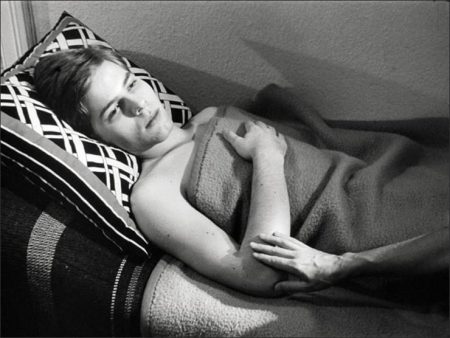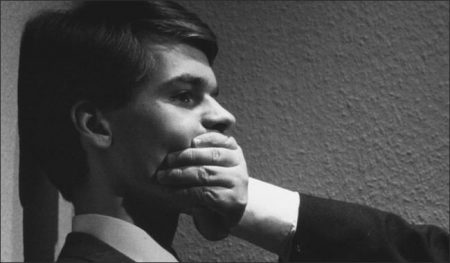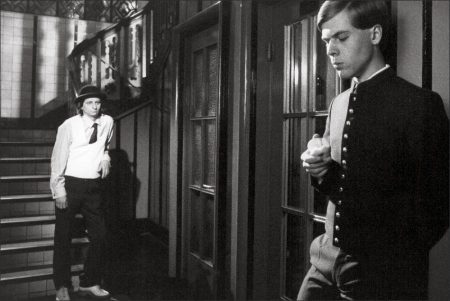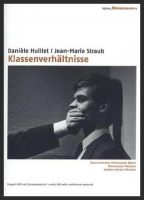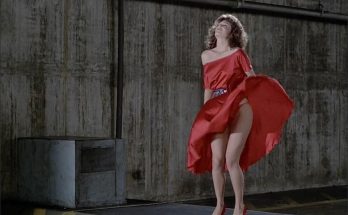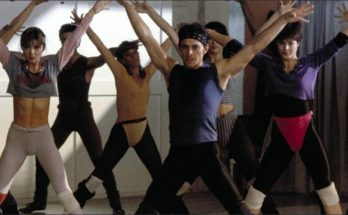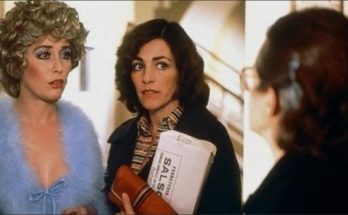Klassenverhältnisse, known in English as Class Relations, in French as Amerika, rapports de classe, is a 1984 film by the French filmmaking duo of Jean-Marie Straub and Danièle Huillet. It is based on Franz Kafka’s unfinished first novel, Amerika.
The German filmmaker Harun Farocki appears as one of the leads, and the film also features a cameo from American experimental filmmaker Thom Andersen.
A documentary was made about the filming process, Jean-Marie Straub und Danièle Huillet bei der Arbeit an einem Film.
Style of the Film
As Franz Kafka never visited the United States, the film was intentionally shot in Europe, with the bulk of shooting occurring in Germany. The film features prominently architecture, flora and costuming (including a policeman in a bobby helmet) that is unlikely to be found in the United States. Only a handful of shots were shot on location in the United States, including the Statue of Liberty and the Missouri River. Though Huillet and Straub are both French, the film was shot in German, the book’s original language.
The film was shot on black-and-white 35mm Kodak film stock by French cinematographer William Lubtchansky. Like all other Straub-Huillet films, it only uses location sound recorded at the same time as the image, emphasizing cinema’s documentary nature over the pictorial.
Class Relations: An Interview and Shooting Methods
The following two texts are from Cahiers du Cinéma no. 364, October 1984: “Something That Burns Within the Shot: An interview with Straub and Huillet” and a report on their shooting methods “Straub-Huillet: The Smallest Planet in the World” by Alain Bergala. The translations are by Ted Fendt who has graciously donated them to Kino Slang. Extreme thanks go to him and to the authors of these very comprehensive pieces on Klassenverhältnisse (Class Relations, 1984).
Jean-Marie Straub: We began by wanting to make a short film that actually turned into the first reel of the film and that corresponds to the short story that Kafka published in 1913 and to the first chapter of the novel. It was only after I looked at what he had added to this short story that I said to myself, “We could try to do the whole thing.” But I wasn’t sure we’d be able to. If it had been The Castle, which I’m just now reading and which I consider to be one of the most important books in contemporary literature, I would have held onto my short film because I find that it’s so literary, The Castle, it exists so much on its own that I would have abandoned it.
But where did the desire to make a film of the first chapter of Amerika come from?
J.-M. Straub: It came from the desire to make a film in German because it had been clear right away that we didn’t want to shoot it in the United States. And then we always go back and forth a bit between films where there is less fiction and those where there is more fiction. After History Lessons, we made Moses and Aron, after Moses and Aron, we made Fortini/Cani. Then, after Too Early, Too Late, we wanted to do another fictional film and to go back to the tone of Machorka-Muff, with an element of Ubu. The back and forth is also between 16 and 35mm and between large and small budgets.
Between Too Early, Too Late, which is by all appearances our least fictional film, and this one, which really is a return to fiction, there was the short, preparatory exercise of En rachâchant, which was like an instigator for Amerika. But the Kafka was the extra push and firm return to the beginning, Machorka-Muff.
Amerika is a pre-war novel since for the most part it was written between 1912 and 1914. You’ve called your film Class Relations. For you, what is similar between the period in which the text was written and today?
J.-M. Straub: The economic crisis. We wanted to make a film that confronted the period in which Kafka wrote with our own, to see how things are similar and how they are different. Alas, they are too similar! That’s why we immediately threw out the idea of doing a period film. And that’s something that I’m very proud of in this film, this equilibrium between old things, like the police officer costumes, the cars, the sets, and the architecture, and things that are entirely modern like electric trains, telephones, and modern typewriters.
Kafka, for us, is the only major poet of industrial civilization, I mean, a civilization where people depend on their work to survive. That’s why there is this permanent fear of losing your job, there are traces left by the fact of having been afraid, and there is constantly misery that appears and is threatening.
Danièle Huillet: It’s a world where a sense of justice has no place. It isn’t the fact that Kafka didn’t go to America that made us not want to shoot in the US. It’s because in this book the relationships between people are much more German than American. For Germans, Karl is a “Tor,” a fool, not in the clinical sense but like in Parsifal.
J.-M. Straub: A fool in Hölderlin’s sense of the word. It’s a voyage across communities of German immigrants in the United States. Even their linguistic community is German.
There’s something profoundly democratic about the way that your film poses the question of main character/secondary characters. When a character that Karl meets appears, he exists in a whole and immediate manner, the film takes him completely into consideration until he leaves the screen and we meet another one. In your film you also chose to get rid of groups and masses of people. In Orson Welles’ The Trial, on the contrary, we often see Anthony Perkins in the foreground and masses of people behind him.
J.-M Straub: When Kafka talks about 40 girls typing, he puts his camera on the ceiling and he films 40 of them.
D. Huillet: It’s true that there’s a choice there: we show one elevator and not 40. In fact, there is one filmmaker who could have shown 40 elevators, he’s dead, and the machine that would have helped him to do it is dead as well. It’s not Welles, it’s Stroheim.
J.-M. Straub: That’s how Amerika had to be done; the way Stroheim reconstructed Monte Carlo. But since we weren’t able to do that, it was more worthwhile to go entirely in the opposite direction.
Apart from that choice, you also took out the scenes with groups, like the ones in the bellhop’s quarters.
D. Huillet: We tightened certain scenes, like the first conversation with the head cook. At that moment, in the book, he was turned towards a very dirty, smoky bar where people were on top of each other. There were spectators, extras, and we didn’t want to show any extras.
J.-M. Straub: We also got rid of what happens after the audition for the Oklahoma Theater where there was a banquet before they get on the train. And in the train there’s a compartment where the people he’s with are smoking, playing cards, making noise, and where they are so close together that Karl has trouble getting to a window to see the landscape. None of that is in the film.
D. Huillet: But that’s an old thing for us since already in the Bach film we were reproached for not showing the people who were listening, below, in the church. When we saw Heaven’s Gate, we said that audiences have even learned to see clearly and that you can no longer “sell” them the extras. But filmmakers are no longer able to film scenes like that because one no longer manages to bring back to life…
J.-M. Straub: The other day, at the Cinematheque in Beaubourg, we saw a film by Stroheim that we didn’t know, Hello Sister. It’s great to see all that we’ve lost, in cinema, along the way. Because democracy shouldn’t only play a part among the characters but also at the equilibrium between the characters and the space in which they are shown. When Stroheim shows a street, the street exists. When a character crosses a street, it’s terrifying; you feel the danger of a street, the traffic, and a human being in a street.
And the human being isn’t more important than the traffic, the traffic isn’t less important than the human being. And when you see a dog who throws himself against the curb – it’s a shot that lasts only a moment – it’s really terrifying. There are very few people who are still able to do that. I think that Kafka has that sense and it’s what interested us and what we modestly tried to do, not as well as Stroheim, with other means, but in that way.
Two things that have practically disappeared in most films are the sets, because television has none of that…
J.-M. Straub: Even space has disappeared. Today spectators are shown a space that doesn’t exist. It’s what bored me so much in Fassbinder’s last films, except maybe Querelle: we no longer know that we have two feet on something or on what planet we were on. Today, in films, you know longer know that it’s a wall or a door that opens. To film doors that open, to put people in a car, to film them in the street is very difficult. You have to pose the question of what three dimensional space is. In films made for TV, it’s cleared away, it isn’t necessary for it to be there, if so it’s a bad TV movie.
Concretely, what does it mean for you to pose that problem?
J.-M. Straub: Well, at the editing phase we find ourselves with 25 hours of synched film. We’ve burned 245,400 ft. of negative.
D. Huillet: Which makes the shooting ratio 1:20.
Why so much?
D. Huillet: Because it’s short shots. That’s when you realize that Bresson isn’t crazy.
J.-M. Straub: Neither was Chaplin, who shot even more still. Because he filmed action. If you film action, either the first take is good or you have to shoot 30 more, and it’s only the 27th that’s good. Sometimes with a guy who opens a door, sits down and moves a pinky, it’s only on the 27th take that he manages to do it freely in a frame, that’s the rhythm (partition) that imposed itself and that we discovered with him.
And that, that is never produced before the 13th take. We noticed during the editing – it’s a bit pretentious to say it like this but it also brings us back to the question of democracy – that that’s how Sade should be filmed if you were filming Sade. We thought about that while looking at Klara and Karl’s relationships in particular. This film could have been called Karl Rossmann or the Misfortunes of Virtue.
You’ve made the character of Karl a figure that is a bit blank, he isn’t characterized…
D. Huillet: I believe that the fact that he wasn’t characterized is what seduced us, at the beginning, in the choice of this actor and it’s what then scared us a bit. But at the same time – and I hope that this is felt in the film – he always judges what happens to him.
J.-M. Straub: It’s true that you could talk about a blank slate there…What happens, I believe, is that he has no specific social existence.
D. Huillet: Except for when he is with people who are below him on the social ladder.
J.-M. Straub: In his relations with the stoker, for example, it’s a sentimental petit-bourgeois side that comes out.
At the end of the film, there is this amazing shot on the train where, for once, Karl is entirely equal, in the image, with the boy who is seated next to him.
J.-M. Straub: If that shot is impressive, it’s because for once there is no longer the third dimension. And moreover, it’s the only handheld shot.
Do you consider this ending to be the end of the novel or not?
J.-M. Straub: Max Brod says that Karl had to find his parents, that he would find them in heaven, so to speak. Others claim that that’s not true. I don’t know, but for me it stops there. I was totally incapable of inventing a utopia. The ending is the moment that he gets out of this mess and goes to a place where he will finally no longer be threatened, where the machine of lies will cease to function (we’ve never invented a character where the steam roller, the spiral of lies goes as far as in the extremely strong arguments of the hotel manager: it’s horrifying). At the end, he’s sitting with someone who will no longer threaten him and he is going towards a place where one hopes everything will be different.
If you consider that the whole film is a descent, then at the end we rediscover a kind of innocence.
J.-M. Straub: Yes, the whole film could be a vertical line and there, on the contrary, is the first time that you are on the planet. Everything becomes horizontal. Or should become so.
At that moment there is also the rediscovered innocence of the countryside.
D. Huillet: It’s funny. For this shot of the landscape seen through the train window, Jean-Marie was disappointed, he had imagined a sort of flash of the landscape…
J.-M. Straub: Let’s say that I didn’t want to do a “Straubian” shot. We had filmed entire reels of the landscape but I thought I was going to only use a few seconds. Danièle said to me, “There’s nothing you can do, this landscape supports itself.” Finally I let myself be convinced by Danièle and by the material.
This moment where Karl Rossmann begins to escape the steamroller of lies is the moment that you chose to inscribe the truth of the landscape, since you actually shot those shots in America.
J.-M. Straub: Yes, it’s no longer a set at all there, the United States of 1920 in Germany today. They take off for a new world, towards possible utopia.
Why did you shoot in Hamburg?
J.-M. Straub: When I left France in 1958 and I had been sentenced to a year in prison, I wanted to live in Hamburg. And that’s where I had been, after Amsterdam (where Gustav Leonhardt, who we wanted to act in our first project, Chronicle of Anna Magdalena Bach, practically ready in 1959, lives) and after East Germany (where most of Bach’s manuscripts and partitions were located). But we said to ourselves that it would possibly be easier to find money in Munich. So we had lived in Munich and we shot Chronicle in 1967!
I really loved Hamburg. When we thought of the Kafka film, I immediately thought of the house where Karl makes himself put back the letter from his uncle. That’s a house where we already shot some shots from Chronicle. Once the permission to shoot for 10 nights in this house was obtained – which was not certain – we abandoned the idea of Berlin as a possible location and we began scouting locations in Hamburg.
Why Hamburg? Because it’s a port, and it’s from there that he leaves. What you see at the beginning and what should help the projectionists to find the frame before the opening credits is a monument in the port of Hamburg, a pirate who had his head cut off with several others in 1411 by the patricians in Hamburg, because he threatened the nascent business of the Hanse. Let’s say that it’s the last image that Karl Rossmann has of the old continent.
What determined the choice of the black and white?
J.-M. Straub: At first, I wanted to return to black and white, that’s why in between we did En rachâchant in black and white, a bit as an exercise. Then I had to give it up, saying to myself, “Orson Welles shot The Trial in black and white, why does Kafka have to necessarily be in black and white?” Finally, I came back to it, a bit impulsively…
D. Huillet: It was important in facilitating the back and forth between the present and the past.
J.-M. Straub: Especially in Germany, where everything is so American, colors aren’t American.
How did you do the subtitles?
J.-M. Straub: Danièle worked on her translation, all alone for 3 years, every time she had a free moment during the rehearsals, the location scouts, etc…
D. Huillet: I must say that in French, Kafka doesn’t exist. It’s extremely difficult to translate into French: it becomes too weighty or unfaithful. When you do the subtitles, you’re lucky because the text is there. The subtitles are only an aid to hear the text. I don’t translate everything but what I translate I translate as literally as possible.
J.-M. Straub: The untranslated things never interrupt the continuity of the discourse. What is missing is often purely descriptive. But what is translated respects the spoken rhythm as much as possible. People have to be able to see the image without spending their time reading subtitles and those who don’t know German have to hear a bit of German for once, without being there to catch any concepts from the reading.
What does this film represent, for you, in your cinematic progression?
J.-M. Straub: What we try to do, with each film, is to open up a whole range. In From the Clouds to the Resistance, we tried to open the range of feelings as much as possible, from extreme horror to the extreme joy of life. Here we tried to open up the range of emotions as much as possible…
I believe that what we’ve looked for, consciously since Moses and Aron, is monumentality (that’s Seguin’s word). The monumentality of the character in relation to the set, the monumentality of the set in relation to the character. Something that in the spirit of two painters who I never think about while shooting but who I think about while imagining. The first is Giotto, not Giotto in general, but the one who I discovered in 1951 by riding my bike to Scrovegni Chapel in Padua.
Films don’t have anything worthwhile if you don’t manage to find something that burns somewhere in the shot. And most filmmakers no longer have any relationship to the language they were born into, in which they work. There are films where the manner that people talk has nothing to do with the house in which they were born which is the same as their mother tongue. A specific language, not a universal language, because cinema is not a universal language the way the Italians, Lizzani and others pretend.
Speech is a touchstone for judging films: there are films where the German or Italian language becomes sick (those by the Taviani brothers or Francesco Rosi, for example). The other aspect is that at each second of each shot, what Renoir called the magical, the magic of reality, must be felt. And that’s why Stroheim is the most important, more important than Griffith and John Ford, even though for me the most important thing that I know is Civil War in How the West Was Won.
That everything you show is both magnificent and the opposite must be felt. Bunuel’s idea that we don’t really live in the best of all possible worlds, but that in spite of everything it’s the best of all possible worlds because we haven’t yet found a better one… The other painter is the one who painted Montagne Sainte-Victoire so often and who said “Look at this mountain.”
He was trying to capture it as a mountain and not something else. It wasn’t abstract painting although it already went beyond that, it was already cubism and something that was richer than cubism. He said, “Look at this mountain, it was once fire.” And that, that goes for everything that we show: it’s like this but it could be different, it’s magnificent and horrible, man is not the center of the universe. Or again Rosa Luxemburg’s idea: the death of an insect is no less important than the death of the revolution.
Klassenverhältnisse (1984)
Directed by: Danièle Huillet, Jean-Marie Straub
Starring: Christian Heinisch, Nazzareno Bianconi, Mario Adorf, Laura Betti, Harun Farocki, Manfred Blank, Anna Schnell
Screenplay by: Franz Kafka (Novel)
Cinematography by: Caroline Champetier, William Lubtchansky, Christophe Pollock
Film Editing by: Danièle Huillet, Jean-Marie Straub
Distributed by: New Yorker Films
Release Date: February 21, 1984
Views: 249
